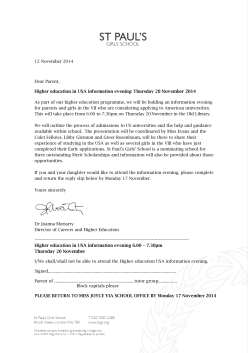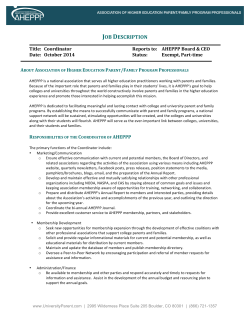
www.beaconenglish.com Text: Teaching at a University
Text: Teaching at a University Context 1. How are universities different to high schools? a. __________________ b. _______________________ c. __________________ d. _______________________ e. __________________ 2. What are the qualities of a good teacher? a. __________________ b. _______________________ c. __________________ d. _______________________ e. __________________ 3. What are the advantages of going to university? a. __________________ b. _______________________ c. __________________ d. _______________________ e. __________________ Match the words in the box with their definitions below Initiatives - reward - contributing strategies - rote learning - construct theories - relevant - innovativion- current 1. _______________ original, new 2. _______________ motivation, ambition 3. _______________ prize, award 4. _______________ give, supply 5. _______________ related, linked 6. _______________ make 7. _______________ to memorize rather than understand 8. _______________ present-day, modern 9. _______________ plans 10. ______________opinions, views, beliefs www.beaconenglish.com Teaching at a University An American academic, Newman, characterized a university in the 19th century as: “a place of teaching universal knowledge […] (a place for) the diffusion and extension of knowledge rather than its advancement.” Newman argued that if universities were not for teaching but rather for scientific discovery, then they would not need students. Most interestingly, during this century, while still teaching thousands of students each year, the resources of most universities have been steadily channeled away from teaching into research activities. Most recently, however, there have been strong moves in both North America and the United Kingdom to develop initiatives that would enhance the profile of the teaching institutions of higher education. In the near future, therefore, as well as the intrinsic rewards gained from working with students and the sense that they are contributing to their overall growth and development, there should soon be extrinsic rewards, in the form of job promotion, for those pursuing academic excellence in teaching in universities. In the future, there will be more focus in universities on the quality of their graduates and their progression rates. Current degree courses, whose assessment strategies require students to learn by rote, and which do not require the student to interact with the material, or construct a personal meaning about it or even to understand the discipline, are resulting in poor learning outcomes. This traditional teaching approach does not take into account modern theories of education, the individual needs of the learner, nor his or her prior learning experience. In order for universities to raise both the quality and status of teaching, it is first necessary to have some kind of understanding of good practice. A 1995 report, compiled in Australia, lists eight qualities that researchers agree are essential to good teaching. As such, good teachers….. Good teachers… A are themselves good learners – resulting in teaching that is dynamic, reflective and constantly evolving as they learn more and more about teaching; B display enthusiasm for their subject and the desire to share it with their students; C recognise the importance of context and adjust their teaching accordingly; D encourage deep learning approaches and are concerned with developing their students’ critical thinking skills, problem-solving skills and problem-approach behaviours. E demonstrate an ability to transform and extend knowledge, rather than merely transmit it; F recognise individual differences in their students and take advantage of these; www.beaconenglish.com G set clear goals, use valid assessment techniques and provide high-quality feedback to their students; H show respect for, and interest in, their students and sustain high expectations of them. As well as aiming to engage students in the learning process, there is also a need to address the changing needs of the marketplace. Because in many academic disciplines the body of relevant knowledge is growing at an exponential rate, it is no longer possible, or even desirable, for an individual to have a complete knowledge base. Rather, it is preferable that he or she should have an understanding of the concepts and the principles of the subject, have the ability to apply this understanding to new situations and have the motivation to seek out the information that is needed. As the world continues to increase in complexity, university graduates will need to be equipped to cope with rapid changes in technology and to enter careers that may not yet be envisaged, with change of profession being commonplace. To produce graduates equipped for this workforce, it is essential that educators teach in ways that encourage learners to engage in deep learning which may be built upon in the later years of their course, and also be transferred to the workplace. The new role of the university teacher, then, is one that focuses on the students’ learning rather than the instructor’s teaching. The syllabus is more likely to move from being a set of learning materials made up of lecture notes, to a set of learning materials made up of print, cassettes, disks and computer programs. Class contact hours will cease to be the major determinant of an academic workload. Teachers will then be released from being the sole source of information transmission and will become instead more a learning manager or coordinator, able to pay more attention to the development and delivery of education rather than content. Student-centered learning activities will also require innovative assessment strategies. Traditional assessment and reporting has aimed to produce a single mark or grade for each student. The mark is intended to indicate three things: the extent to which the learned material was mastered or understood; the level at which certain skills were performed and the degree to which certain attitudes were displayed. A deep learning approach would test a student’s ability to identify and tackle new and unfamiliar ‘read world’ problems. A major assessment goal will be to increase the size and complexity of assignments and minimize what can be achieved by memorizing or reproducing content. Wherever possible, students will be involved in the assessment process to assist them to learn how to make judgments about themselves and their work. www.beaconenglish.com Activities Section 1 – Text Analysis 1. How many paragraphs does the text have? ______________________ 2. What tense is the text written in? ______________________________ 3. Who is the audience of this text? ______________________________ 4. What is the purpose of this text? ______________________________ 5. Where would you find this text? ______________________________ 6. Is this text an advertisement? _________________________________ Section 2 – Language Analysis 7. Highlight all of the words that relate to education and learning. 8. Which word in the text means teacher? _________________________ 9. Which word in the text means job? ____________________________ 10. Which word in the text means coming from outside a particular person or thing? ______________________ 11. Which word in the text means to have something as a plan or intention? ______________________ Questions 1 - 4 Do the following statements agree with the information given in Reading Passage 2? WriteTRUE if the statement agrees with the information FALSE if the statement contradicts the information NOT GIVEN if there is no information on this 1. Newman believed that the primary focus of universities was teaching. 2. Job promotion is already used to reward outstanding teaching. 3. Traditional approaches to assessment at degree level are having a negative effect on the learning process. 4. University students have complained about bad teaching and poor results. Questions 5 – 9 Look at the eight qualities A-H of ‘good teachers’ in Reading Passage 2 and the statements below (Questions 5-9). Match each quality to the statement with the same meaning. Write the correct letter A-H next to the statement. Good teachers 5. can adapt their materials to different learning situations. 6. assist students to understand the aims of the course. 7. are interested in developing the students as learners. 8. treat their students with dignity and concern. 9. continually improve their teaching by monitoring their skills. www.beaconenglish.com Questions 10 – 13 Choose the correct letter, A,B,C or D. Write your answer in boxes 10-13 on your answer sheet. 10. In the future, university courses will focus more on A developing students’ skills and concepts. B expanding students’ knowledge. C providing work experience for students. D graduating larger numbers of students. 11. According to the author, university courses should prepare students to A do a specific job well. B enter traditional professions. C change jobs easily. D create their own jobs. 12. The author believes that new learning materials in universities will result in A more work for teachers. B a new role for teachers. C more expensive courses. D more choices for students. 13. The author predicts that university assessment techniques will include more A in-class group assignments. B theoretical exams. C problem-solving activities D student seminar presentations. www.beaconenglish.com
© Copyright 2025





















